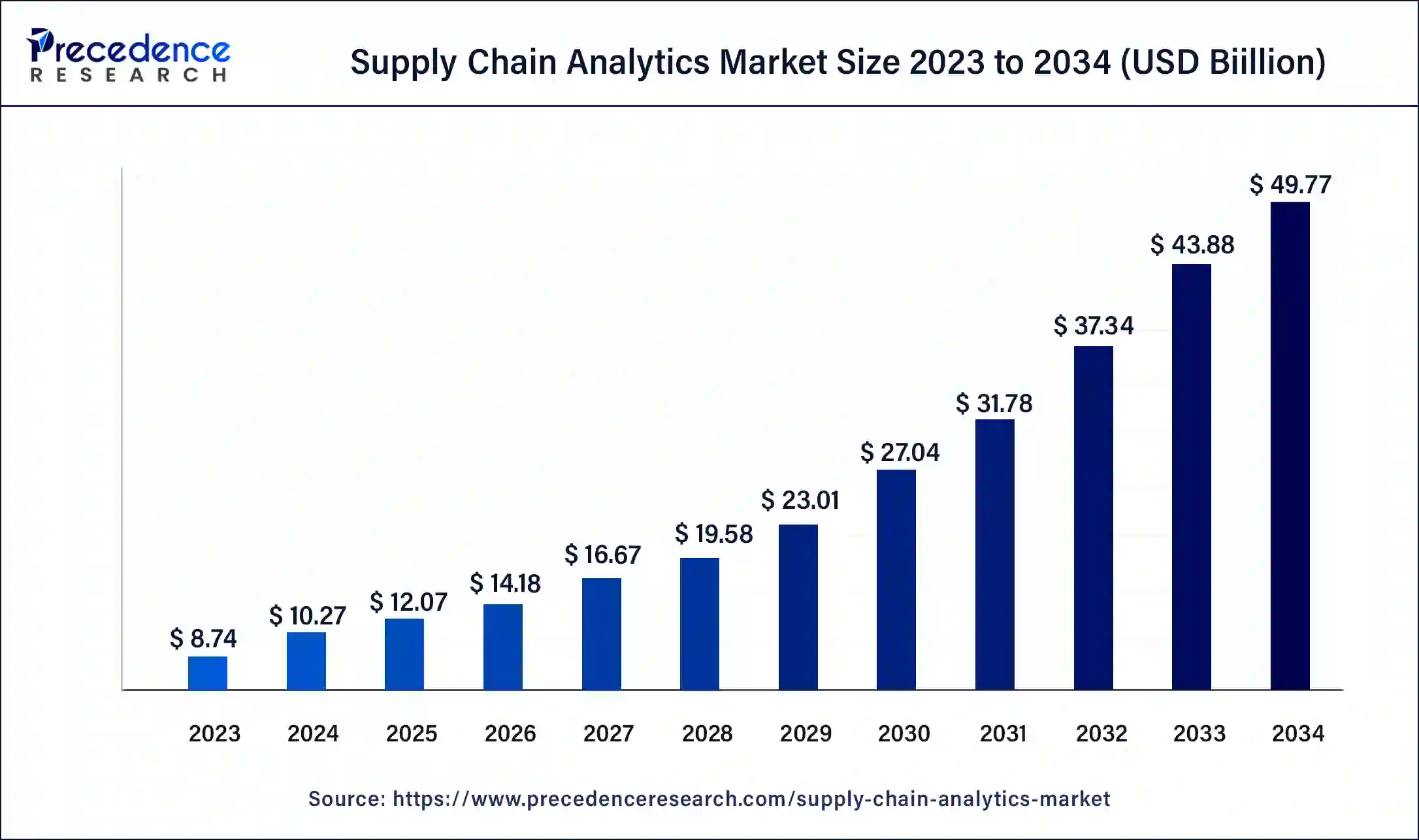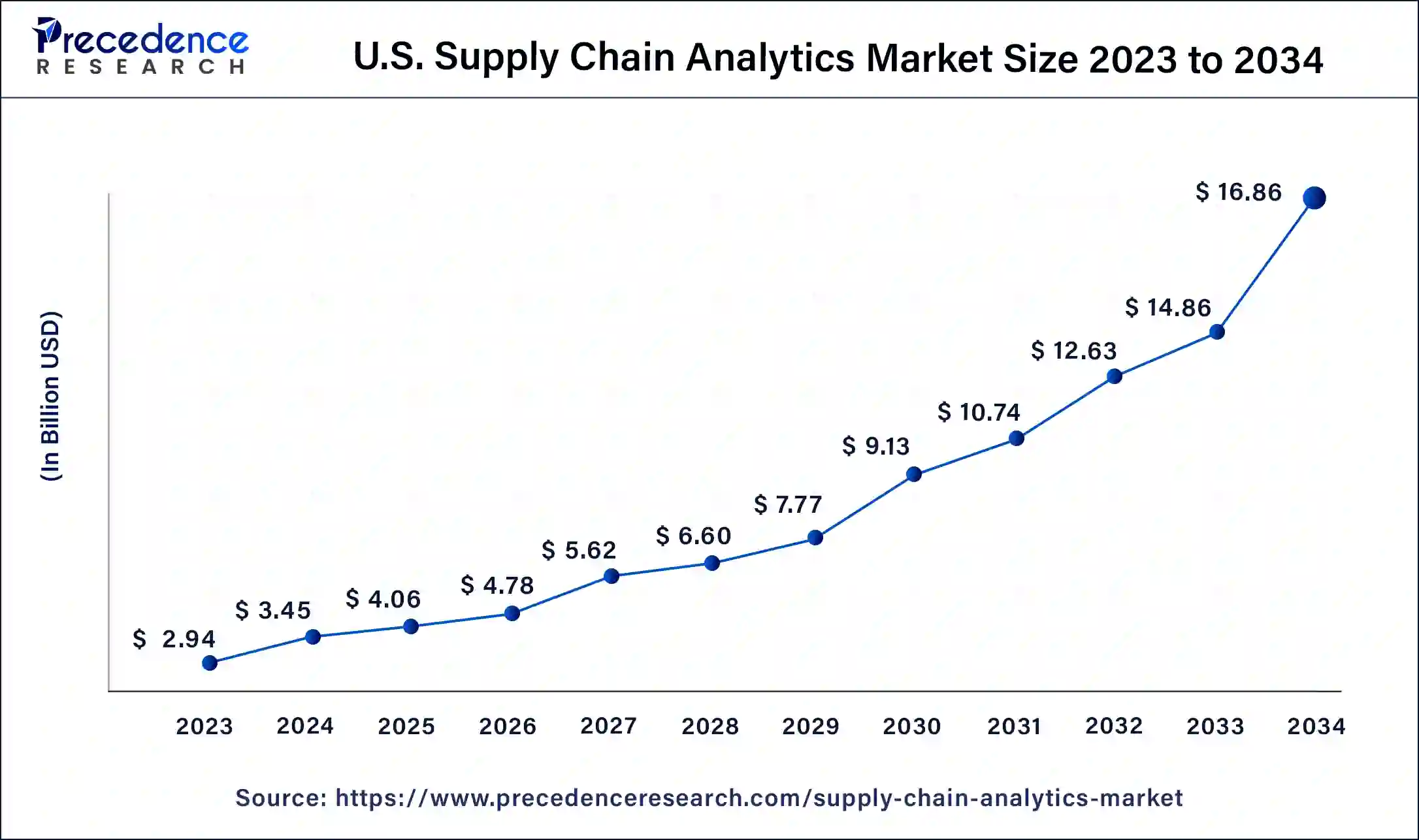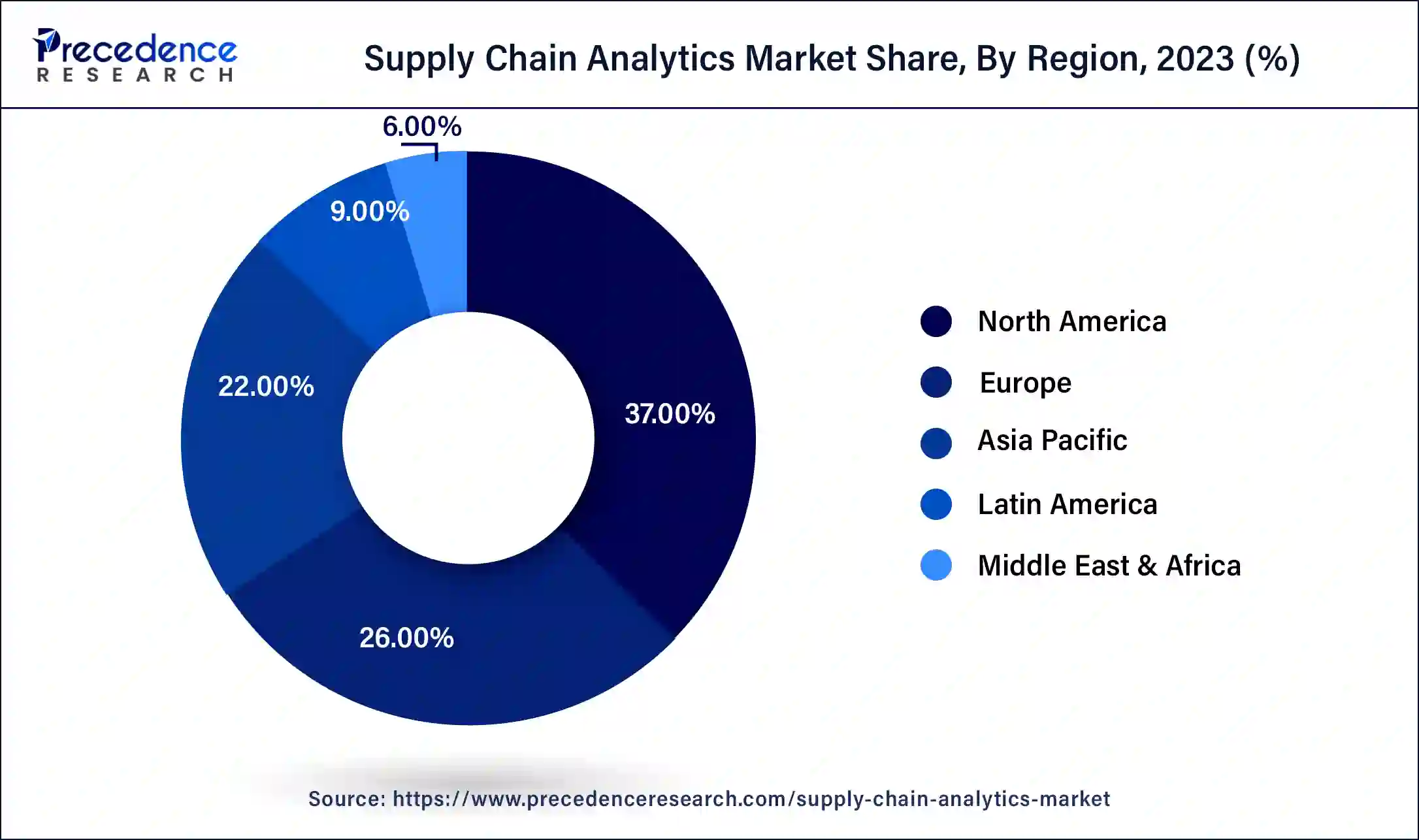December 2024
The global supply chain analytics Market size was USD 8.74 billion in 2023, estimated at USD 10.27 billion in 2024 and is anticipated to reach around USD 49.77 billion by 2034, expanding at a CAGR of 17.09% from 2024 to 2034.
The global supply chain analytics market size accounted for USD 10.27 billion in 2024 and is predicted to reach around USD 49.77 billion by 2034 with soild a CAGR of 17.51% from 2024 to 2034. The North America supply chain analytics market size reached USD 4.20 billion in 2023.

The U.S. supply chain analytics market size was valued at USD 2.94 billion in 2023 and is expected to be worth around USD 16.86 billion by 2033 at a remarkable CAGR of 17.19% from 2024 to 2034.

North America held the largest share of the supply chain analytics market in 2023; the region is expected to sustain its dominance during the forecast period. The rising utilization of supply chain-related services for profitability and improvement purposes is observed as a significant factor in supporting the market’s development throughout the predicted timeframe. Infrastructural development, rapid adoption of advanced services, and the presence of major key players in the region are a few other factors to fuel the market’s growth in the upcoming period.
Moreover, the rising demand for real-time insights and inventory from multiple organizations is propelling the market’s growth. In addition, the increasing investments in start-ups that require data analytics services with minimal IT investments will supplement the market’s growth in the region. The market’s growth is driven by the penetration of data analytics services in the retail sector of North America.

Asia Pacific is observed as the fastest-growing region for the supply chain analytics market. The rise in the use of supply chain management services for business purposes, along with improvisation in the industrial infrastructure, is considered a driving factor for the market’s growth in the region. Technological advancement and increased expenditure on small and medium-scale organizations in this region will drive the development of the supply chain analytics market in the Asia Pacific. Countries including China, India, and Japan are considered to be the most significant contributors to the market’s growth in the region.
With the rising industrialization, multiple businesses in the region are focusing on the improvement of the supply chain network between suppliers, companies, and end-users. Additionally, the booming e-commerce industry in the region is another factor boosting the growth of the market during the forecast period.
During the forecast period, Europe is expected to grow at a significant rate. The market growth in Europe is attributed to the rising technological innovations, increase in the demand for supply chain management, and expansion of end-users such as growing e-commerce businesses. Moreover, Europe's well-established and advanced healthcare sector shows an enormous demand for supply chain analytics and data management services to offer and manage electronic health records. This factor fuels the market’s growth in the region.
The global supply chain is useful for the maintenance and development of the future economy, it is useful for the day-to-day basic necessities like food and fuel to luxurious goods, supply chain analytics used data analytics to enhance and support the supply chain management. Due to the large and complex organizational type supply chain maintains the big data of information to understand the requirement understanding trends and efficiencies and insightful development.
It can be helpful in the maintenance, operations, and optimization of the supply chain. The growth of the e-commerce industries will help to drive the supply chain market and due to the higher demand and inventory, the supply chain analytics market will grow significantly.
The supply chain analytics used for businesses can effectively be planning the research and development, manufacturing, sourcing, and supply chain for the product and demand in the market. Supply chain analytics is used for the range of data provided by the supply chain. The supply chain is used for the business to analyze its operation, sourcing, manufacturing, waste minimization, forecasting, and data synthesis. Medium and large-scale companies will be the highest end-user of the supply chain analytics market due to their large-scale operations and to effectively compete with the market player in the forecast period.
Supply chain analytics enhance the operations and decision-making capacity of the enterprise by giving them a high-quality data picture by use of supply chain analytics. Supply chain analytics increase the demand in several manufacturing industries to increase productivity and give real-time data across the value chain or the changes made in any production process and changes in real-time data in any region.
Additionally, the rise in the demand of the consumer for better delivery of the product and in-time delivery will result in the growth in demand of the supply chain analytics market. Implementing supply chain analytics in the organization will provide highly efficient productivity, improve quality, and profitability increase in the market growth by analyzing the insights of the market so the manufacturer can take the data-driven decision to improve the profitability of the organization.
| Report Coverage | Details |
| Growth Rate from 2024 to 2034 | CAGR of 17.09% |
| Market Size in 2023 | USD 8.74 Billion |
| Market Size in 2024 | USD 10.27 Billion |
| Market Size by 2034 | USD 49.77 Billion |
| Largest Market | North America |
| Base Year | 2023 |
| Forecast Period | 2024 to 2034 |
| Segments Covered | Solution, Service, Deployment, Enterprise Size, End-use, and Region |
| Regions Covered | North America, Europe, Asia-Pacific, Latin America and Middle East & Africa |
Rapidly growing adoption in manufacturing industries
The supply chain analytics market can be driven by the high adoption of the service in various manufacturing industries and organizations for better decision-making processes. Supply chain analytics provide better and more efficient supply chain management by delivering the real-time data of the organization according to the current requirement of the consumers from the organization. It reduced the manufacturing cost of the product and reduced the time of production. As supply chain analytics deals with the planning of product material, sourcing, production, and distribution hence it is useful for planning these factors and increasing the profitability of the manufacturer.
In the field of supply chain analytics, supply chain analysts aforementioned the manufacturer's historical sale of that specific product and predict when the demand for the product will increase or decrease that is called demand forecasting, due to the demand forecasting process the manufacturer is known as the future events and analyze the market growth. All these factors would drive the higher demand for the supply chain analytics market in the organization.
Uncertainty in data and future prediction
While there are many benefits to supply chain analytics like it collects data forecasting for the profitability of the business, giving solutions to the supply chain management, etc. but there are some limitations in supply chain analytics though the data is streamlined according to the analytics sometimes it is hard to humans to understand it. Another problem with supply chain analytics is that the organization can not only rely on the data collected by the supply chain analytics for-profit and decision-making process, but sometimes data is of low quality and hamper the decision-making and growth of the organization.
The deployment of artificial intelligence in supply chain analytics
Artificial Intelligence is getting abundant popularity over the years. In modern supply chain analytics, AI is one of the prominent factors for better service and increasing the profitability of the organization. The AI supply chain analytics works with a smart machine that can solve the task of problem-solving in several departments of the organization. Smart industry manufacturing is fully automated and works by the IIOT (Industrial Internet of Things) can operate the overall supply chain without and manual operating system. AI which is used by the organization will be more efficient in machine-made data flowing out of IoT devices. It has better connectivity for the effective decision-making process.
Sales and Operations segments held the largest market share in 2023. The growth of the sales and operation segment is attributed to the increase in the utilization of resources and cost consideration by multiple industries. Sales and operation process works effectively when the small number of outcomes are combined with the method of solving the issues such as process roles, operational issues, and roles and responsibilities.
The logistics analytics segment will increase significantly in the supply chain analytics market during the forecast period. Logistics analytics solution works with the transportation network for the predicted market demand of the service or product.
The planning and procurement segment is expected to rise in the anticipated timeframe. The increase in the planning and procurement segment is attributed to supply chain planning includes future data forecasting for the cost, production, and manufacturing for better logistics operations.
The professional service-type segment is expected to increase in the supply chain analytics market in the forecast period. The professional service works with the prevention of data loss or data theft, professional service ensures the new technology is compatible with the previous services in the department for effective workflow.
The support and maintenance segment is expected to register significant growth in the anticipated period. Support and maintenance ensure the smooth and effective flow of the supply chain analytics in the organization. It understands the technicalities of software and maintenance of the analytics during the breakdown. It is one of the most important factors for the supply chain analytics market.
The cloud segment is expected to show the fastest growth during the forecast period. The technological adoption in the organization and the large-scale adoption of IoT devices in the organization will lead the OEM consumers, depending on the cloud-based platform. Cloud-based platforms increase production and manufacturing customization over large and medium-scale organizations.
The Large-Scale enterprise segment will dominate the supply chain market in the forecast period. The rising need for automation and monitoring of resources and enhancing the decision-making process, especially in large-scale enterprises, will drive the large-scale enterprise segment over the anticipated time period.
The small and medium-scale enterprises segment will likely show a significant increase during the predicted period. The deployment of information technology (IT) in supply chain management for small and medium-scale enterprises will fuel the segment's growth in the upcoming period.
The manufacturing segment held the largest share of the market in 2023; the demand for supply chain analytics in manufacturing units for data management is fueling the segment’s growth. Manufacturing units require supply chain analytics for real-time data management and to improve performance for timely production and distribution. The rising focus on smart supply chains from manufacturing companies is expected to boost the segment’s growth during the forecast period.
The retail and consumer goods segment is expected to witness promising growth during the forecast period. The rapidly growing e-commerce sector is expected to grow the demand for supply chain analytics in the retail industry. E-commerce and retail businesses require supply chain analytics to get visibility across production, warehousing, and distribution networks. Furthermore, the rising focus on enhanced customer relationships and scaling omnichannel practices in retail and consumer goods industries will fuel the demand for supply chain analytics by propelling the segment’s growth.
Segments Covered in the Report:
By Solution
By Service
By Deployment
By Enterprise Size
By End-use
By Geography
For inquiries regarding discounts, bulk purchases, or customization requests, please contact us at sales@precedenceresearch.com
No cookie-cutter, only authentic analysis – take the 1st step to become a Precedence Research client
December 2024
January 2025
October 2024
April 2025